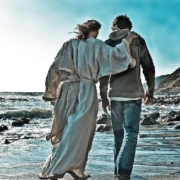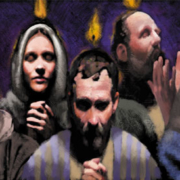Passover
Tonight all across America Jewish families will be participating in an event that is thousands of years old. That event is called Passover. Passover signifies when God the Father came to set His people free, and bring judgment down on the demonic gods of Egypt. During this night, the angel of death visited Egypt looking for the sign of the blood of the lamb over the door posts of each home. In the homes which had the lambs’ blood over the door posts death would passover and in the homes where the blood was not to be found death entered in. May I suggest to you that this night you participate in a time of family prayer and communion with your family? Pray and ask for the blood of Jesus, the Lamb, to be applied to the door posts of your property, home, marriage, family, children and children’s children, and possessions – that the angel of death may passover. Pray also for your neighbors, and loved ones that they may also receive the Blood of the Lamb and apply it to their lives also.
If you want to actually practice a traditional Jewish Passover you can take the notes below and put them into practice, or you can simply don load a seder, or passover service online. Here are the notes I have on celebrating the Passover:
WHAT PASSOVER CELEBRATES
As in all Biblical holy days, Passover is both a holy day of remembrance and a holy day of prophecy. Passover for the Jewish people is the annual celebration of God delivering Israel out of Egypt (Exodus 12). The entire service, with its various ceremonies, is designed to help the Jewish people remember the great workings of God when, through signs and wonders, He freed the Jewish people from the bondage of the Egyptians and delivered them to the Promised Land of Israel. Passover is a holy day of redemption picturing how God used the death of an innocent lamb to redeem the firstborn sons ofIsrael from death and free the nation of Israel from slavery.
Passover is certainly the most important Biblical holy day for Christians. It also clearly pictures the redemption Jesus provided for our sin. The last meal Jesus ate with His disciples in the Upper Room was a Passover meal. It was during this Passover meal that Jesus took a piece of unleavened bread and a cup of the fruit of the vine and said to His disciples that these represented His body given in death and His blood shed for the remission of sins (Luke 22:19, 20). The Messiah used the story of the redemption from Egypt to illustrate the redemption He provides from sin. The Passover meal beautifully pictures the redemption Jesus provided for us on the cross. Having a Passover dinner, either in the church or in one’s home is a wonderful opportunity to celebrate the death and resurrection of the Lord Jesus in its historical, New Testament setting as it was celebrated by the disciples with the Messiah. We can rejoice, “For Christ our Passover lamb has been sacrificed for us” (I Corinthians 5:7).
HOW PASSOVER IS CELEBRATED IN THE JEWISH HOME
The Seder is really like a family dinner where the family gathers around the table to worship God and follows a prescribed order of service to celebrate the miraculous events of that first Passover. Because Passover begins the Feast of Unleavened Bread (Exodus 12:13-16), no leaven is be eaten during the seven dayswhich begin with the Passover meal. In the daysproceeding Passover, the mother cleans the home to remove all leaven so that as the family celebrates the Passover they can eat it without defilement. Because regular flour, bread, and legumes are considered leavened, only matzah in its various forms is used in the meal.
At sunset, on the night of Passover, the family gathers around the table. The evening begins with the mother lighting the candies at the table and saying a blessing. After this, the father begins leading the family through the service which includes drinking four times from the cup of the fruit of the vine (grape juice) and discussing the items on the Seder plate (page 7 gives details about these items).
The following is an outline of the service for the evening:
WHAT PASSOVER CELEBRATES
As in all Biblical holy days, Passover is both a holy day of remembrance and a holy day of prophecy. Passover for the Jewish people is the annual celebration of God delivering Israel out of Egypt (Exodus 12). The entire service, with its various ceremonies, is designed to help the Jewish people remember the great workings of God when, through signs and wonders, He freed the Jewish people from the bondage of the Egyptians and delivered them to the Promised Land of Israel. Passover is a holy day of redemption picturing how God used the death of an innocent lamb to redeem the firstborn sons ofIsrael from death and free the nation of Israel from slavery. Passover is certainly the most important Biblical holy day for Christians. It also clearly pictures the redemption Jesus provided for our sin. The last meal Jesus ate with His disciples in the Upper Room was a Passover meal.It was during this Passover meal that Jesus took a piece of unleavened bread and a cup of the fruit of the vine and said to His disciples that these represented His body given in death and His blood shed for the remission of sins (Luke 22:19, 20). The Messiah used the story of the redemption from Egypt to illustrate the redemption He provides from sin. The Passover meal beautifully pictures the redemption Jesus provided for us on the cross. Having a Passover dinner, either in the church or in one’s home is a wonderful opportunity to celebrate the death and resurrection of the Lord Jesus in its historical, New Testament setting as it was celebrated by the disciples with the Messiah. We can rejoice, “For Christ our Passover lamb has been sacrificed for us” (I Corinthians 5:7).
HOW PASSOVER IS CELEBRATED IN THE JEWISH HOME
The Seder is really like a family dinner where the family gathers around the table to worship God and follows a prescribed order of service to celebrate the miraculous events of that first Passover. Because Passover begins the Feast of Unleavened Bread (Exodus 12:13-16), no leaven is be eaten during the seven dayswhich begin with the Passover meal. In the daysproceeding Passover, the mother cleans the home to remove all leaven so that as the family celebrates the Passover they can eat it without defilement. Because regular flour, bread, and legumes are considered leavened, only matzah in its various forms is used in the meal.
At sunset, on the night of Passover, the family gathers around the table. The evening begins with the mother lighting the candies at the table and saying a blessing. After this, the father begins leading the family through the service which includes drinking four times from the cup of the fruit of the vine (grape juice) and discussing the items on the Seder plate.
I. THE CUP OF SANCTIFICATION – The drinking of this cup begins the service. The Passover story is told using the elements from the Seder plate. The middle matzah of the Matzah Tash is broken and then hidden.
II. THE CUP OF JUDGMENT – This cup focuses on God judging the gods of Egypt through the plagues. The bitter herbs are taken. The Charoset is eaten.
AT THIS TIME THE MEAL IS SERVED.
Ill. THE CUP OF REDEMPTION – This cup focuses on the redemption of God. The Passover story is concluded.
IV. THE CUP OF PRAISE – This cup focuses on praising God for calling a people unto Himself.
As can be seen, the meal is both preceded and followed by the story of Passover.
THE HAGADDAH & THE MESSIANIC HAGADDAH
Through the centuries, since God first instituted Passover as the Israelites came out of Egypt, many traditions have been added to the Passover celebration. Yet, the basic elements of the Passover found in the original instructions are still present, including the bitter herbs, the matzah (unleavened bread), and the symbol of the Passover lamb. For centuries, the Passover tradition was celebrated based upon traditions handed down orally. Eventually, these oral traditions were put into writing called the Haggadah. The word “Haggadah” is taken from the Hebrew, meaning, “to tell” (Exodus 13:8). Though there are many different variations in how the Haggadah is written, they all contain the basic outlines of the service that dates back to antiquity.
THE SEDER PLATE
The Seder plate is the ceremonial setting for the first part of the service. Included are items which will be partaken of. These help the people better understand the meaning of the holy day. There will need to be one Seder Plate (use a 10 inch Plate) per table or per 10 people. The following is a list of items to beincluded on the Seder plate and the proportions for each person or per plate as indicated:
ITEM DEFINITION QUANTITY
Karpas Parsley 1 sprig per person
Maror Ground horseradish 1 teaspoon per person (red, if available)
Charoset Apples, nuts & spices 1 tablespoon per person (recipe on pg. 12)
Salt Water (for dipping of parsley) 1-2 1/2 oz. cup per plate
Zeroah *Shank bone of a lamb Head table only.
Betzah **Hard cooked egg Head table only
The arrangement of the items on the Seder Plate is as follows:

MATZAH TASH(orBread Holder)
This item isof major importance in the Passover Service. There should be one Matzah Tash (or Bread Holder)for each table. The Matzah Tash consists of:
One large dinner-sized paper plate
Two dinner-sized napkins
Three full-sized unbroken matzahs
The three whole sheets of matzah are placed inside the dinner napkin so that one sheet is inside each section of the napkin. The second napkin is placed on top of the Matzah Tash.
During the service, a volunteer at each table will be called on to remove the center piece of matzah break it in two, and “bury” one half in the extra napkin (to be”resurrected” later). This ceremony ismost important and will be explained further later.

A suggested Passover Dinner:
Main Course: Roasted Chicken or Beef or Turkey with
Vegetables such as: Squash, Carrots, Asparagus, Broccoli and a green salad
Roasted or baked potatoes
Dessert- can be fruit or if possible a dessert without leaven- check Passover recipes
Matzah as the bread substitute
Recipe for the Apple salad for the Seder plate
CHAROSET – Serves 12 at 1 heaping tablespoon per person
1 cup chopped, peeled apples 1 teaspoon honey 1/4 cup chopped walnuts
1-2 tablespoons grape juice 1/4 tsp. cinnamon
Mix all ingredients. This mixture is so tasty you may want to make extra.
NOTE: Charoset is supposed to turn brown to represent the old fashioned brick mortar the Israelites used in Egypt, so it should be ground to that consistency (a blender or food processor is recommended). The above proportions are very approximate. It should be sweet but the honey flavor should not dominate. The taste of each ingredient should be subtly noticeable in the final mixture.







